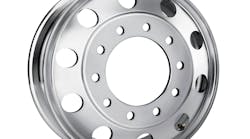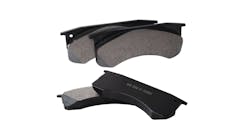Truck tires represent a significant investment for fleets of all sizes and configurations. That’s why it’s important for fleets to better their “tire returns,” says Brian Buckham, general manager, product marketing, Goodyear Tire & Rubber Company (https://corporate.goodyear.com), one of the world’s largest tire companies.
“This begins by selecting the right tire for the application and then engaging in regular maintenance practices,” Buckham says. “It is imperative that fleets choose the right tire for their application. Fleets should first define what their tires will be ‘asked’ to do. Then, they should work with their commercial tire dealers and tire service providers to select the most appropriate tire or tires.”
Different trucks and applications often require different tires, notes the 20-year trucking industry veteran, “and equipping trucks with the wrong tires can lead to sub-optimal performance. This underscores the importance of consulting with a qualified tire dealer.”
By way of example, Buckham says a Goodyear Commercial Tire & Service Center or an authorized Goodyear commercial tire dealer have the experience and know-how to help a fleet make the right choice.
Maintenance
Like many other truck components, tires require proper post-installation maintenance if a fleet wants to get optimal performance and service life out of their tires, Buckham points out.
“Good truck tire maintenance programs begin with frequent air pressure checks,” he says. “Generally speaking, maintaining correct inflation pressure is probably the single most important maintenance practice that a fleet can employ to positively impact tire wear, casing life and overall tire performance.”
Both overinflation and underinflation should be avoided, as they change the tire’s footprint, which can result in irregular wear and loss of traction, he says. Overinflation can contribute to a handful of issues, including a harsher ride. Underinflation also can create a number of issues which can sometimes be even more serious and cost fleets time and money.
It is the air inside the tire that actually carries the truck’s load, he explains. Underinflation causes the tire to flex more as it rolls down the road, resulting in internal heat build-up. Heat is a tire’s enemy, and can negatively impact tire life and performance.
Furthermore, insufficient inflation can impair fuel economy since underinflated tires can force truck engines to work harder, “just like it’s more difficult to pedal a bicycle with underinflated tires,” says Buckham.
Truck tires are designed to run at specific pressures based on the load they are carrying, he adds.
“Keep in mind that ambient temperature has an impact on inflation levels,” Buckham says.
Tire and tire service dealers can help fleets determine the correct pressure for the tires that their trucks are running. Load and inflation information also can be found at www.goodyeartrucktires.com.
He suggests that fleets check inflation pressure levels at least once a week using a calibrated tire gauge, and more often, if possible.
Truck Alignment
Maintaining proper truck alignment can also help optimize truck tire ROI, says Buckham. When a vehicle is not aligned properly, two of the fleet’s larger maintenance expenditures – fuel and tires– can be negatively impacted.
“Keeping a truck aligned may seem like an expensive proposition, but it’s an investment that can pay dividends when it comes to helping achieve longer tire life by reducing the likelihood of irregular tread wear or improving rolling resistance, which can directly impact fuel consumption,” he says.
What’s more, tires that have to be taken out of service early likely do not provide the proper return on investment, especially if they no longer have an acceptable tire casing for retreading.
“When thinking about alignments, it is important to not only consider traditional front-end alignment,” he advises. “Drive axles should be brought into alignment as well.
“Misaligned drive axles not only affect the wear of drive axle tires, they also affect steer axle tire wear when the driver has to turn slightly left or slightly right to keep a truck moving in a straight line. Similarly, trailer axles that are out of alignment can be problematic.”
If any of the wheels on an 18-wheeler tractor trailer are not in alignment, the total drag on the vehicle could be increasing, reducing fuel economy.
“Misalignment is not a condition that corrects itself,” notes Buckham. “An improperly aligned truck requires professional care. Alignments are a key ingredient of any good tire and vehicle maintenance program.”
Visual And Tactile Inspections
“When thinking about tire maintenance, don’t forget about regular visual and tactile inspections, as these can also provide a lot of useful information about a tire’s current condition,” Buckham says.
Examples of things to check for include unusual wear patterns, such as feathering and cupping.
He also recommends running one’s hand over a tire’s tread, feeling for abnormalities. At the same time, inspect the whole tire for damage, such as cuts, cracks, blisters or bulges. Depending on the condition, the tire may need to be taken out of service.
Here again, he says tire and tire service dealers should be consulted for more information.
“The maintenance practices noted here require varying investments of time and money, but all of them can benefit fleets in real, measurable ways,” concludes Buckham.





